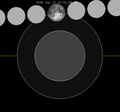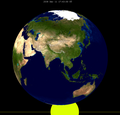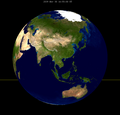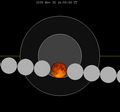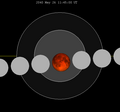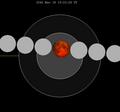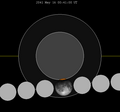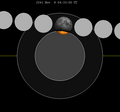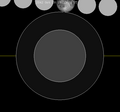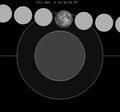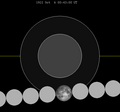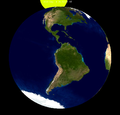Top Qs
Timeline
Chat
Perspective
October 2042 lunar eclipse
Extremely short lunar eclipse From Wikipedia, the free encyclopedia
Remove ads
A penumbral lunar eclipse will occur at the Moon’s ascending node of orbit on Tuesday, October 28, 2042.[1] with an umbral magnitude of −0.974. A lunar eclipse occurs when the Moon moves into the Earth's shadow, causing the Moon to be darkened. A penumbral lunar eclipse occurs when part or all of the Moon's near side passes into the Earth's penumbra. Unlike a solar eclipse, which can only be viewed from a relatively small area of the world, a lunar eclipse may be viewed from anywhere on the night side of Earth. Occurring only about 12 hours before perigee (on October 28, 2042, at 7:30 UTC), the Moon's apparent diameter will be larger.[2]
This event marks the beginning of lunar saros cycle 156 according to some sources, and will be visually imperceptible to the naked eye. Many other sources denote this eclipse as a miss.[3]
According to some sources, it will be the last of 5 metonic cycle eclipses occurring every 19 years on October 28, while the other sources calculate the Moon will miss the shadow.
Remove ads
Visibility
The eclipse will be completely visible over much of Africa, Europe, Asia, and western Australia.
  |
Eclipse season
This eclipse is part of an eclipse season, a period, roughly every six months, when eclipses occur. Only two (or occasionally three) eclipse seasons occur each year, and each season lasts about 35 days and repeats just short of six months (173 days) later; thus two full eclipse seasons always occur each year. Either two or three eclipses happen each eclipse season. In the sequence below, each eclipse is separated by a fortnight. The first and last eclipse in this sequence is separated by one synodic month.
Remove ads
Related eclipses
Summarize
Perspective
Eclipses in 2042
- A penumbral lunar eclipse on April 5.
- A total solar eclipse on April 20.
- A penumbral lunar eclipse on September 29.
- An annular solar eclipse on October 14.
- A penumbral lunar eclipse on October 28.
Lunar Saros 156
- Followed by: Lunar eclipse of November 8, 2060
Lunar eclipses of 2038–2042
This eclipse is a member of a semester series. An eclipse in a semester series of lunar eclipses repeats approximately every 177 days and 4 hours (a semester) at alternating nodes of the Moon's orbit.[4]
The penumbral lunar eclipses on January 21, 2038 and July 16, 2038 occur in the previous lunar year eclipse set, and the penumbral lunar eclipses on April 5, 2042 and September 29, 2042 occur in the next lunar year eclipse set.
Metonic series
The metonic cycle repeats nearly exactly every 19 years and represents a Saros cycle plus one lunar year. Because it occurs on the same calendar date, the Earth's shadow will in nearly the same location relative to the background stars.
Tritos series
This eclipse is a part of a tritos cycle, repeating at alternating nodes every 135 synodic months (≈ 3986.63 days, or 11 years minus 1 month). Their appearance and longitude are irregular due to a lack of synchronization with the anomalistic month (period of perigee), but groupings of 3 tritos cycles (≈ 33 years minus 3 months) come close (≈ 434.044 anomalistic months), so eclipses are similar in these groupings.
Remove ads
See also
Notes
External links
Wikiwand - on
Seamless Wikipedia browsing. On steroids.
Remove ads





